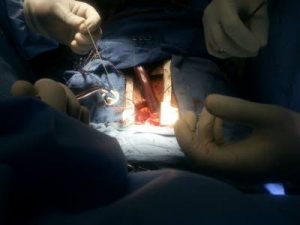NOT wanting to be left behind, doctors at the University Hospital of the West Indies (UHWI) in St Andrew have taken steps to improve outcomes for people needing aortic valve replacement, by performing two minimally invasive procedures, a first in Jamaica.
The first procedure was done on May 19 and the second on June 13.
Consultant cardiothoracic surgeon at the UHWI Dr Sunil Stephenson, one of the doctors who did the operation, told the Jamaica Observer that the aim is to move on to transcatheter aortic valve replacement in a few years, but for now, Jamaica is at the point of using smaller incisions for patients who need aortic valve replacement.
The transcatheter aortic valve replacement is a less invasive procedure that does not require open-heart surgery, and according to Dr Stephenson, is done through the groin by passing guide wires and catheters, and placing the valve through a very small incision. He pointed out that specialised training and equipment would be needed for this technique.
The consultant cardiothoracic surgeon told Your Health Your Wealth that a patient may need aortic valve replacement if blood leaks back into the heart, which is called aortic regurgitation, or if the blood flowing out of the heart is reduced because of narrowing, which is known as aortic stenosis.
“It is really where the rest of the world is going because a lot of centres, like in the United Kingdom, they have actually moved on to doing most of their isolated aortic valve replacement — meaning they just need the aortic valve replaced — they are actually moving more and more towards the minimally invasive technique,” Dr Stephenson said.
Blood flows out of the heart and into a large blood vessel called the aorta. The heart and aorta are separated by the aortic valve.
The consultant cardiothoracic surgeon explained that the standard procedure for replacing the aortic valve is a sternotomy — creating an opening down the middle of the chest.
“Usually we go full length, where we divide the entire length of the sternum so it’s a long incision in the middle of the chest,” he said. “Minimally invasive aortic valve surgery is a much smaller incision that we use to get access to the aortic valve, and we do the procedure through that.”
Dr Stephenson said the approach is evidence-based and that the aim of the hospital is to practise along international standards.
“We don’t want to be left behind at all, we are keeping up,” he said.
Having successfully performed the first minimally invasive aortic valve replacement, Dr Stephenson noted that it means that Jamaica has the technical skills to do it again. He also said that the surgery is a variation of the standard procedure and that no specialised equipment is needed.
“So from now on we will be able to offer the procedure to suitable patients who qualify for it.”
The first patient, 70-year-old Dorcas Allen from Kingston, told Your Health Your Wealth that she is doing okay.
“Ahead of the surgery, I didn’t really know what was going on, but after coming on the ward I was expecting that I would be feeling extra pain, but it wasn’t anything like that,” she said.
Allen said she wasn’t afraid of going into the procedure because the doctors had explained to her what would happen.
“Going into the operation room you see when they started certain things, but after they put you to sleep, you don’t know anything more,” she said laughing.
The minimal pain felt is just one of the benefits to be had from doing the operation, Dr Stephenson shared.
“Usually with the full sternotomy or the standard technique, they divide the entire bone right down the middle. Now, with that procedure, patients bleed more and they usually have a lot more pain,” he said.
“With the minimally invasive procedure, the benefits have been shown. The patients have less pain after the surgery, they also bleed less, and they are able to get discharged from the intensive care unit and the hospital a lot quicker, which means back home and back to work sooner.
“And it also looks better, so there is a cosmetic benefit as well,” he continued.
He pointed out that the risks are the same as with the standard procedure, and that surgery time for the minimally invasive procedure, because doctors are using a smaller incision, can be a little longer.
“So operating time is increased, but the trade-off that you get for the benefit of the patient is that the surgeon spends more time operating,” he noted.
He explained that Allen had aortic stenosis, but pointed out that she qualified for the minimally invasive approach because no additional procedure was needed.
“So the patient was having symptoms of aortic stenosis, which led her to our clinic. She only needed the aortic valve replaced, so she qualified for the minimally invasive aortic valve replacement,” he said, adding that he was not sure why the procedure was only now being done in Jamaica.
“Three of us have been trained to do it, so we just decided to do it because she qualified for the procedure,” he said.
He also told Your Health Your Wealth that Allen was a public patient and that the procedure was done entirely by a local team.
The team included: Dr Stephenson; assistant surgeon Dr Rodger Miller, who is chief resident in Cardiothoracic Surgery; anaesthetist Dr Jason Toppin, who is a consultant cardiac anaesthetist; assistant anaesthetist Dr Neville Burke; and scrub nurse Jennifer Fyffe.
“The standard technique is easier when you go through the bigger incision and the minimally invasive is actually a little more technical, but because she qualified for it we decided to offer it to her so she could really get the benefits that it offers,” he said.






